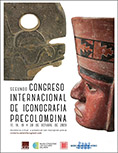Zea E-Books
Date of this Version
2023
Document Type
Article
Citation
Publicado en Segundo congreso internacional de iconografía precolombina, 2023. Actas. Victòria Solanilla Demestre, editora. Lincoln, Nebraska: Zea Books, 2024. doi: 10.32873/unl.dc.zea.1710
Abstract
En las vasijas tipo códice del periodo Clásico Tardío (600 a 900 d. C.), así como en diferentes tipos de monumentos, existen representaciones de tronos portátiles en escenas palaciegas que fueron utilizados como vehículos para llevar al soberano a diferentes lugares del señorío, o fuera de sus fronteras, con el fin de supervisar actividades rituales, militares y diplomáticas, entre otras. En este sentido, el objetivo del presente trabajo será analizar las distintas representaciones de palanquines en el arte maya, así como destacar su mención en los textos jeroglíficos del Clásico maya, donde se asocian con el vocablo piit, ‘litera, palanquín’.
In the codex-type vessels of the Late Classic period (600 to 900 AD), as well as in different types of monuments, there are representations of portable thrones in palace scenes that were used as vehicles to carry the sacred ruler to different places in the kingdom, or outside its borders, in ordert to supervise ritual, military, and diplomatic activities, among others. In this sense, the objective of the present paper will be to analyze the different representations of palanquins in Mayan art, as well as highlight their mention in the hieroglyphic texts of the Classic Maya, where they are associated with the word piit, “litter, palanquin.”


Comments
Copyright © 2023 Roberto Romero Sandoval, Octavio Quetzalcóatl Esparza Olguín, & Pablo Alberto Mumary Farto.